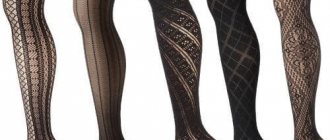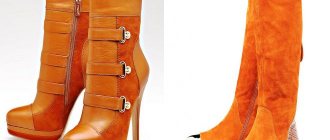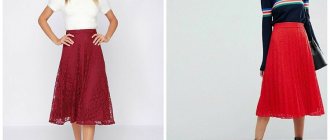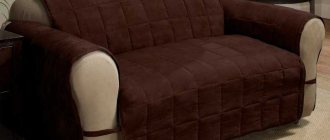Is it possible to wear tights during pregnancy?
Such products, like other items of clothing, can be worn during pregnancy, the main thing is that they do not cause discomfort to the expectant mother. For women in an interesting situation, a special model of tights has been designed, for which the risk of unpleasant sensations during wearing is minimized.
The most popular types of tights used by pregnant women:
- nylon: elastic tights made of nylon. They come in different densities, this indicator is measured in denier (den). The higher the den, the denser the product. Tights with a density of 10–15 den are suitable for evening wear. 20 denier items are the most popular everyday option. Tights with a density of 40 den are considered an office option. In cool weather, 70 den tights will be appropriate.
- insulated: the composition contains elastane, acrylic, microfiber or cotton are also added.
- compression: preventive and therapeutic knitwear. Available in various sizes, has several compression classes. The need to wear compression tights and the degree of compression should be determined by a phlebologist.
How to choose tights?
Medical knitwear is available in a variety of designs. It is advisable to choose special compression tights for pregnant women on the recommendation of a doctor - he will advise how to calculate the size and set the degree of compression. For consultation, you must make an appointment with a phlebologist, a specialist in venous diseases. The doctor will give advice on choosing from a set of parameters.
- Class of compression provided by underwear.
The doctor makes the choice of knitwear after familiarizing himself with the patient’s medical history and conducting a thorough examination, including palpation of blood vessels. Self-diagnosis often leads to worsening of the condition. Knitwear should compensate for the condition of blood vessels, and not be useless. - Linen size.
The effectiveness of treatment and prevention depends on this parameter. If the size is large, the result will not be noticeable. If it is small, deterioration of the general condition and complications are possible. The best way to determine the size is to use special tables from manufacturers and try on, which is better not to refuse, since underwear cannot be exchanged or returned. - Life time.
The stated service life is 6–10 months. You will learn about the exact period of operation guaranteed by the manufacturer by examining the packaging. - Material. The elastic threads of medical knitwear are double braided with dense cotton fibers. Synthetic materials are not welcome in the production of underwear for expectant mothers.
- Quality mark. Doctors recommend choosing products that meet the RAL standard. This packaging marker guarantees excellent performance and long service life.
- Manufacturer. It is better to give preference to proven brands. Low prices should be viewed as suspicious - quality doesn't come cheap. The minimum cost of good models is 6,000 rubles.
Regular tights during pregnancy
Pre-pregnancy tights usually do not cause discomfort to women in the first trimester of pregnancy. However, as the pregnant belly grows, you have to take into account more and more nuances and even make small tweaks when choosing tights.
What to look for when buying regular maternity tights.
- The bead should be elastic, but soft. This will minimize the pressure exerted by the elastic band on the abdominal area.
- The size is determined based on the woman's height and weight. Already established mothers recommend buying tights several sizes larger.
- A little trick: the role of insulated tights for pregnant women can be played by ordinary insulated tights, worn backwards. To do this, the tights must be a couple of sizes larger than required, without a designated heel, and must have a back insert (2 seams in the area of the buttocks).
Special tights for pregnant women: rules of choice
For a while, wearing larger-than-usual tights can save you from having to buy special maternity tights. Do you know what causes the most inconvenience in late pregnancy? These are elastic bands of tights! And, even if you buy regular tights a size larger, they are still designed to fit the waist of a standard figure. Some people simply cut the tight belt of tights without being embarrassed by the creeping arrows, some try to wear tights with a low waist, forgetting that their belt will be on the most protruding part of the tummy, and some wear regular tights, folding the belt under the tummy . Each of these methods causes a lot of inconvenience and does not solve the main problem.
Tights for pregnant women. Photo: queenbee.com.au
In the modern world, pregnancy and the first period of motherhood can proceed with comfort, which was inaccessible to most just 30 years ago. Instead of reusable diapers and endless hand washing, there are now disposable diapers, which free up mom’s time and help save energy and hands; A variety of children's clothing for newborns allows you not to keep your baby swaddled, but gives him the opportunity to move and develop from the first days of life. Against this background, special tights for pregnant women are just one of the little things that make the life of the expectant mother easier. Should they be neglected?
Surely many people do not buy special tights for pregnant women just to save money. But are you sure that you will really be able to save money without harming your health and the health of your child?
So, if you are going to buy maternity tights, consider a few little things:
- if you buy tights from an unknown manufacturer, carefully study the packaging; pay attention to the composition, even smell the tights (pregnant women have a very enhanced sense of smell), if there is a chemical smell, refuse to purchase;
- before buying tights, consult the seller, read as many reviews as possible on the Internet, remembering that some of them may be custom-made;
- remember that tights cannot be returned or exchanged, so if you make an unsuccessful choice, you will have no one to file a claim with;
- Do not buy maternity tights from an online store unless you are an experienced online shopper;
- when choosing tights, ask the seller to open the package and show you the product; feel the fabric, check the elasticity of the belt;
- Remember that your tummy is constantly growing, so you may need several variations of tights.
Maternity tights will be needed for a short period, but they should be chosen much more carefully than any other. Even the choice of stockings for a wedding is not so important!
We wish you a comfortable pregnancy!
Photo: bondgirlglam.com
Main photo: bondgirlglam.com
Colorful or statement socks show openness and are a great icebreaker or way to connect with others.
People demonstrate their strength, their audacity in the boardroom. The more expressive the socks, the larger the wallet. — Lauren Rothman
Maternity tights size chart
When choosing compression tights for pregnant women, you need to take into account the fact that they do not stretch, and therefore their size must correspond exactly to your measurements.
Usually the sizes of maternity tights are measured in the international sizing system according to the principle S, M, L, XL, XXL, XXXL . They correspond to the measurements in cm shown below.
What secrets of choosing maternity tights do you know? It is very important for us to know your opinion!
Types of compression stockings for pregnant women
There are several types of support stockings; their choice depends on the condition of the pregnant woman's veins.
Preventive
Suitable for pregnant women with healthy veins, so they do not require a doctor’s prescription. These are smooth, transparent stockings with evenly distributed pressure. In appearance, these are ordinary stockings: you can wear them to work, for a walk or on a visit. Even if you have to spend the whole day on your feet, they will not get tired and will not swell until the end of the day. Thanks to silicone inserts, the products are fixed on the hips without slipping. These are stockings in which compression is not measured in mmHg, unlike hospital stockings or compression stockings with different compression classes. The marking of such stockings is density, measured in den: 70 den, 100 den, 140 den, etc.
Hospital
This is knitwear with a lower degree of compression than the stockings of other series - up to 18 mm Hg. Art. Other names for these stockings are anti-embolic or anti-embolic. Hospital knitwear comes only in white so that the doctor can assess the condition of the leg veins without removing the stockings. They are good because they maintain vein tone around the clock and do not need to be removed at night. Due to physiologically calculated compression, which stimulates blood circulation, hospital stockings will support large vessels, prevent blood from stagnating in the legs and prevent blood clots from forming.
Hospital (anti-embolic) stockings have uniform pressure on the muscles and walls of blood vessels throughout the circumference of the leg. The special knitting of compression hosiery helps restore normal functioning of the venous valves. It becomes an additional frame to support the walls of large vessels.
- The lumen of the peripheral veins narrows - primarily the saphenous veins of the leg and thigh.
- The functioning of the venous valve apparatus is normalized.
- A pump effect is created: the working muscles massage the deep veins of the extremities, thereby improving blood flow.
Compression
They are prescribed to women with venous disease (varicose veins, thrombosis, etc.), which was diagnosed before or during pregnancy. There are 4 compression classes:
- 1st compression class . When the first stage of varicose veins has already been diagnosed, heaviness in the legs is observed with the first manifestations of the disease - for example, reticular varicose veins with spider veins or venous edema - it’s time to buy therapeutic knitwear of the 1st class of compression with a pressure of 18-22 mm Hg. Art.
- Compression class 2 . If nodes and seals are already visible on the veins, and in the morning you discover that yesterday’s swelling has still not gone away, the attending physician will prescribe class 2 compression knitwear (23–32 mm Hg). You need to wear it to avoid deep vein thrombosis. It is also prescribed in the period after vascular surgery.
- Compression class 3 . If there are significant symptoms of varicose veins, thrombosis, lymphovenous insufficiency and persistent swelling, the doctor prescribes medical knitwear of the 3rd compression class. Such products create a compression of 33–46 mmHg. Art.
- Compression class 4. Prescribed when the most severe forms of varicose veins, deep vein thrombosis and elephantiasis of the legs are observed, as well as when lymph flow is seriously impaired. These are medical products with a compression of 49 mmHg. Art., which helps to avoid stagnation of blood by artificially pumping it from the legs to the heart.
It is important to remember : no self-medication!
You cannot wear underwear with compression class 1 or higher without a doctor’s prescription.
What are compression tights?
Russian compression or elastic tights are therapeutic tights that protect veins from stretching and reduce varicose and lymphedema during pregnancy.
Medical tights "Intex" consist of two parts. The upper part is sewn together from several parts. The upper part of the tights supports the belly of a pregnant woman with the help of an elastic mesh insert, and prevents the tights from sliding down. A soft elastic band sewn into the upper part of the tights is responsible for this. The lower part is knitted using a seamless method. The lower part of the tights exerts distributed pressure on the legs: maximum (100%) in the shin area, pressure decreases to 70% in the middle of the shin, to 50% in the knee area and to 40% in the middle of the thigh.











